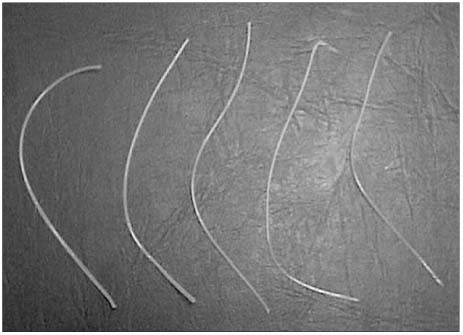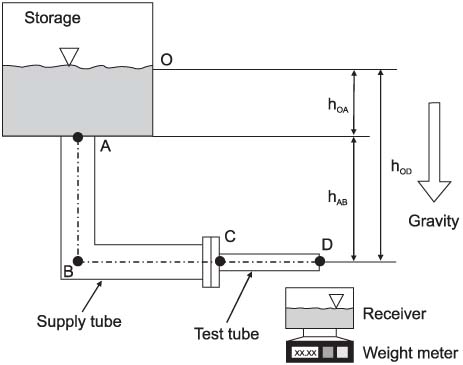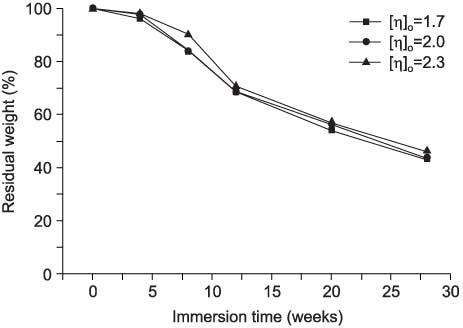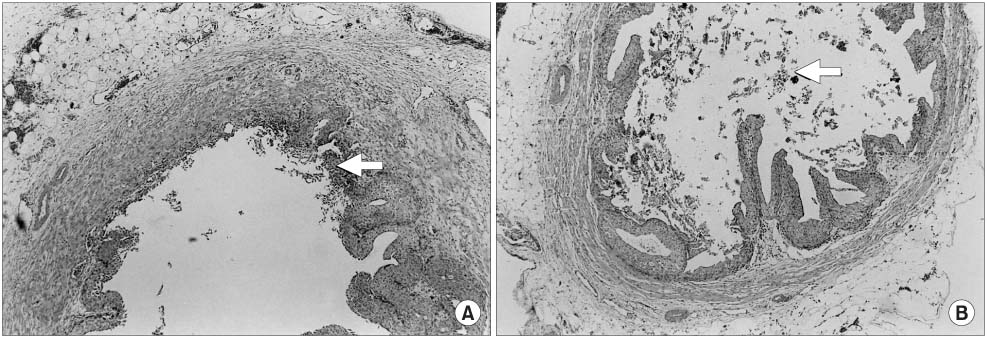Korean J Urol.
2006 Aug;47(8):895-902. 10.4111/kju.2006.47.8.895.
The Evaluation of a Dissolvable Ureteral Catheter in a Rabbit Model
- Affiliations
-
- 1Department of Urology, Chungnam National University College of Medicine, Daejeon, Korea. yongna@cun.ac.kr
- 2Yun Hap Urologic Clinic, Daejeon, Korea.
- KMID: 2294121
- DOI: http://doi.org/10.4111/kju.2006.47.8.895
Abstract
-
PROPOSE: Ureteral stents are commonly placed after routine ureteroscopic procedures to prevent acute obstruction. However, stents can cause significant symptoms and they can require a secondary procedure for removal; further, they may possibly be forgotten. In order to overcome these problems, a temporary ureteral drainage stent capable of dissolving spontaneously was developed to evaluate the tissue reaction and toxicity.
MATERIALS AND METHODS
We developed a dissolvable ureteral catheter composed of polydioxanone (PDO). We evaluated the toxicity and tissue reaction by hematologic (CBC, aminotransferase/alanine transaminase (AST/ALT), blood urea nitrogen, creatinine (BUN, Cr), alkaline phosphatase) and histologic examination (ureter, kidney and liver tissue). Twelve rabbits were placed into groups of four rabbits each: the uninserted control group, group I that had a dissolvable ureteral catheter inserted with harvest at four weeks, group II that had a dissolvable ureteral catheter inserted with harvest at eight weeks, and group III that had a dissolvable ureteral catheter inserted with harvest at twelve weeks.
RESULTS
On histologic examination, the ureter had a normal appearance of transitional cells and it contained the dissolvable ureteral catheter in the ureteral lumen without any inflammatory change. The ureteral surface cells appeared normal after contact with the dissolvable ureteral catheter during the 12 weeks. Liver and kidney tissue showed mild focal inflammatory change, but no definitive difference was noted between the control and groups I, II and III. On the hematologic examination, there was no significant change of the value of CBC, AST/ALT, BUN, Cr and alkaline phosphatase due to the inserted dissolvable ureteral catheter during the 12 weeks.
CONCLUSIONS
A dissolvable ureteral catheter appeared to have no toxic effect, as evidenced by histological and hematological examination. However, further study is warranted in order to overcome the catheter's limitations like for its flexibility.
Keyword
MeSH Terms
Figure
Reference
-
1. Zimskind PD, Fetter TR, Wikerson JL. Clinical use of long-term indwelling silicone rubber ureteral splints inserted cystoscopically. J Urol. 1967. 97:840–844.2. Pryor JL, Langley MJ, Jenkins AD. Comparison of symptom characteristics of indwelling ureteral catheters. J Urol. 1991. 145:719–722.3. Bregg K, Riehle RA Jr. Morbidity associated with indwelling internal ureteral stents after shock wave lithotripsy. J Urol. 1989. 141:510–512.4. Pollard SG, Macfarlane R. Symptoms arising from Double-J ureteral stents. J Urol. 1988. 139:37–38.5. Lennon GA, Thornhill JA, Sweency PA, Grainger R, Mc-Dermott TE, Butler MR. 'Firm' versus 'soft' double pigtail ureteric stents: a randomised blind comparative trial. Eur Urol. 1995. 28:1–5.6. Irani J, Siquier J, Pires C, Lefebvre O, Dore B, Aubert J. Symptom characteristics and development of tolerance with in patient with indwelling double-pigtail ureteric stents. BJU Int. 1999. 84:276–279.7. Joshi HB, Okeke A, Newns N, Keeley FX Jr, Timoney AG. Characterization of urinary symptoms in patients with ureteral stents. Urology. 2002. 59:511–516.8. Seo KK, Oh CH, Moon YT. Complication of indwelling double-J ureteral stents. Koren J Urol. 1990. 31:754–758.9. Pryor JL, Jenkins AD. Use of double-pigtail stents in extracorporeal shock wave lithotripsy. J Urol. 1990. 143:475–478.10. Joshi HB, Stainthorpe A, MacDonagh RP, Keeley FX Jr, Timoney AG, Barry MJ. Indwelling ureteral stents: evaluation of symptoms, quality of life and utility. J Urol. 2003. 169:1065–1069.11. Joshi HB, Newns N, Stainthorpe A, MacDonagh RP, Keeley FX Jr, Timoney AG. Ureteral stent symptom questionnaire: development and validation of a multidimensional quality of life measure. J Urol. 2003. 169:1060–1064.12. Joshi HB, Newns N, Stainthorpe A, MacDonagh RP, Keeley FX Jr, Timoney AG. The development and validation of a patient-information booklet on ureteric stents. BJU Int. 2001. 88:329–334.13. Netto NR Jr, Ikonomidis J, Zillo C. Routine ureteral stenting after ureteroscopy for ureteral lithiasis: Is it really necessary? J Urol. 2001. 166:1252–1254.14. Hosking DH, Mccolm SE, Smith WE. Is stenting following ureteroscopy for removal of distal ureteral calculi necessary? J Urol. 1999. 161:48–50.15. Noh JH, Kim DK, Jeong H. Comparison of stented and unstented patients following ureteroscopy for ureter stones. Korean J Urol. 2002. 43:28–31.16. Denstedt JD, Wollin TA, Sofer M, Nott L, Weir M, D'A Honey RJ. A prospective randomized controlled trial comparing nonstented versus stented ureteroscopic lithotripsy. J Urol. 2001. 165:1419–1422.17. Byrne RR, Auge BK, Kourambas J, Munver R, Delvecchio F, Preminger GM. Routine ureteral stenting is not necessary after ureteroscopy and ureteropyeloscopy: a randomized trial. J Endourol. 2002. 16:9–13.18. Hollenbeck BK, Schuster TG, Faerber GJ, Wolf JS Jr. Routine placement of ureteral stents is unnecessary after ureteroscopy for urinary calculi. Urology. 2001. 57:639–643.19. Chen YT, Chen J, Wong WY, Yomg SS, Hsieh CH, Wang CC. Is ureteral stenting necessary after umcomplicated ureteroscopic lithotripsy? A prospective, randomized controlled trial. J Urol. 2002. 167:1977–1980.20. Beiko DT, Knudsen BE, Watterson JD, Cadieux PA, Reid G, Denstedt JD. Urinary tract biomaterials. J Urol. 2004. 171:2438–2444.21. Olweny EO, Portis AJ, Sundaram CP, Afane JS, Humphrey PA, Ewers R, et al. Evaluation of a chronic indwelling prototype mesh ureteral stent in a porcine model. Urology. 2000. 56:857–862.22. Taylor WN, McDougall IT. Minimally invasive ureteral stent retrieval. J Urol. 2002. 168:2020–2023.
- Full Text Links
- Actions
-
Cited
- CITED
-
- Close
- Share
- Similar articles
-
- Clear visual field ureterorenoscopy by using ureteral catheter
- Pyeloplasty for ureteropelvic junction obstruction : To divert or not to divert
- Easily Removable Ureteral Catheters for Internal Drainage in Children: A Preliminary Report
- Clinical Observation on Surgical Ureteral Injuries
- Ureteral Rupture Caused by a Suprapubic Catheter in a Male Patient With Spinal Cord Injury: A Case Report









